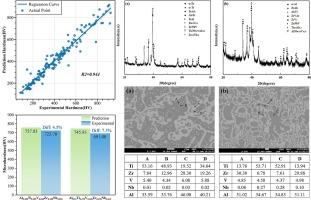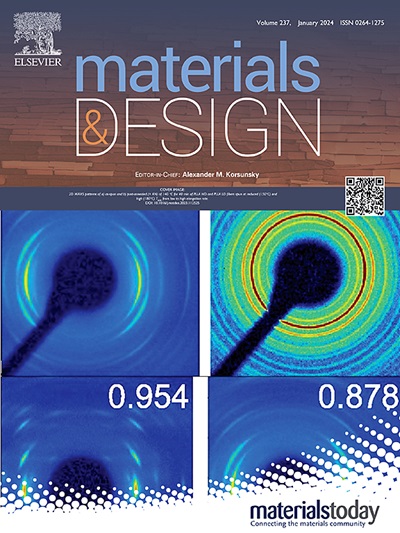堆叠集合学习辅助设计高硬度 Al-Nb-Ti-V-Zr 轻质高熵合金
IF 7.6
2区 材料科学
Q1 MATERIALS SCIENCE, MULTIDISCIPLINARY
引用次数: 0
摘要
为了提高机器学习模型在轻质高熵合金力学性能预测和设计中的准确性和效率,我们采用堆叠集合方法训练了多分类机器学习模型。该集合模型的预测精度高达 0.9457,并具有良好的抗过拟合性能。我们从预测结果中选择了两种具有高硬度的候选高熵合金(Al0.38Ti0.36V0.05Zr0.16Nb0.05 和 Al0.51Ti0.28V0.04Zr0.16Nb0.01),采用电弧熔炼法制备了块体样品。实验测得两个样品的显微维氏硬度分别为 723.7 HV 和 691.0 HV,仅略低于模型预测的硬度值,误差小于 8%。样品的相结构(HCP 和 FCC 的混合物)也与预测结果十分吻合。这表明我们的机器学习方法在预测高熵合金硬度方面非常有效,其准确性已得到实验验证,从而大大提高了新型轻质高硬度高熵合金的设计效率。本文章由计算机程序翻译,如有差异,请以英文原文为准。

Stacking ensemble learning assisted design of Al-Nb-Ti-V-Zr lightweight high-entropy alloys with high hardness
To improve the accuracy and efficiency of machine learning models in predicting and designing the mechanical properties and designing of lightweight high-entropy alloys, we have trained multi-classification machine learning models using stacking ensemble method. This ensembled model achieves high prediction accuracy of 0.9457 and good anti-overfitting performance. Two candidate high-entropy alloys with high hardness from the predicted results (Al0.38Ti0.36V0.05Zr0.16Nb0.05 and Al0.51Ti0.28V0.04Zr0.16Nb0.01) were selected to prepare bulk samples using arc melting method. The experimentally measured micro Vickers hardness of two samples were 723.7 HV and 691.0 HV respectively, and only slightly lower than the hardness values predicted by the model, with an error of less than 8 %. The phase structure of the samples, which is a mixture of HCP and FCC, also agrees well with the predicted results. This indicates that our machine learning approaches is highly effective in predicting the hardness of high-entropy alloys, with accuracy that has been experimentally verified, thereby significantly enhancing the efficiency of designing new lightweight high-hardness high-entropy alloys.
求助全文
通过发布文献求助,成功后即可免费获取论文全文。
去求助
来源期刊

Materials & Design
Engineering-Mechanical Engineering
CiteScore
14.30
自引率
7.10%
发文量
1028
审稿时长
85 days
期刊介绍:
Materials and Design is a multi-disciplinary journal that publishes original research reports, review articles, and express communications. The journal focuses on studying the structure and properties of inorganic and organic materials, advancements in synthesis, processing, characterization, and testing, the design of materials and engineering systems, and their applications in technology. It aims to bring together various aspects of materials science, engineering, physics, and chemistry.
The journal explores themes ranging from materials to design and aims to reveal the connections between natural and artificial materials, as well as experiment and modeling. Manuscripts submitted to Materials and Design should contain elements of discovery and surprise, as they often contribute new insights into the architecture and function of matter.
 求助内容:
求助内容: 应助结果提醒方式:
应助结果提醒方式:


